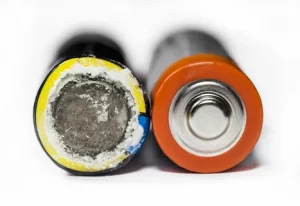Lithium batteries have become an integral part of our daily lives, powering everything from smartphones to electric vehicles. However, concerns about their safety and potential leakage have arisen due to the volatile nature of lithium.
This article aims to explore the truth behind the theory: do lithium batteries leak? By examining the construction, chemistry, common causes of leakage, and safety measures, we will delve into the risks associated with battery leakage and provide insights on how to prevent it.
Additionally, we will discuss potential health and environmental hazards while offering tips for extending the lifespan of these powerful energy sources.
Key Takeaways Do lithium batteries leak?
- Signs of battery leakage include corrosion or discoloration around terminals, manufacturing defects, physical damage, or improper storage
- Corrosive chemicals may be released when a battery leaks
- Unusual odor or excessive heat may indicate leakage
- Prioritize personal safety with protective gear
Understanding Lithium Battery Construction
Lithium batteries are composed of multiple layers that are carefully designed to prevent leakage. These layers include a positive electrode made of lithium cobalt oxide, a negative electrode made of graphite, and a separator that keeps the two electrodes apart. The electrolyte, which is typically a lithium salt in an organic solvent, facilitates the movement of ions between the electrodes during charge and discharge cycles. This construction ensures that the battery remains sealed and prevents any leakage of its contents.
Understanding lithium battery maintenance is crucial for ensuring optimal performance. Over time, factors such as temperature variations, overcharging or deep discharging can degrade the components within the battery and increase the risk of leakage. By adhering to proper charging practices, avoiding extreme temperatures, and monitoring battery health regularly, users can maximize their battery’s lifespan while minimizing the chances of leaks.
Exploring the chemistry behind lithium batteries unveils fascinating insights into their operation and potential improvements without compromising safety.
Exploring the Chemistry Behind Lithium Batteries
Chemical reactions occurring within the interior of lithium-ion batteries can result in the release of potentially hazardous substances. Understanding the chemistry behind lithium batteries is crucial to comprehend their potential leakage and associated effects.
Lithium battery chemistry involves a combination of positive and negative electrodes, an electrolyte, and a separator that prevents direct contact between these electrodes. The positive electrode is typically made of lithium cobalt oxide (LiCoO2), while the negative electrode consists of graphite. The electrolyte, commonly a mixture of organic solvents with lithium salts, facilitates ion movement between the two electrodes during charging and discharging cycles. Leakage can occur when these components degrade or break down due to various factors such as high temperatures or physical damage to the battery. This leakage may lead to corrosion, overheating, or even explosions if not addressed promptly. Transitioning into the subsequent section about common causes of battery leakage reveals further insights into this issue without explicitly stating it as a step.
Common Causes of Battery Leakage
Battery leakage can occur due to various factors. These factors include overcharging, physical damage, and high temperatures.
Overcharging a battery can lead to the breakdown of its internal components and the release of corrosive electrolytes.
Physical damage, such as cracks or punctures in the battery casing, can also result in electrolyte leakage.
Additionally, exposing batteries to high temperatures can cause them to expand and rupture, leading to leakage of their contents.
Overcharging
Overcharging of lithium batteries has been found to have detrimental effects on their performance. When a lithium battery is overcharged, it can lead to the formation of metallic lithium on the anode. This process, known as lithium plating, reduces the overall capacity and lifespan of the battery. Moreover, overcharging increases the internal pressure within the battery, which can result in electrolyte leakage and subsequent damage to the surrounding components.
To illustrate these risks further, consider the following table:
| Overcharging Risks | Preventing Overcharging |
|---|---|
| Reduction in capacity and lifespan | Implementing voltage regulation |
| Formation of metallic lithium | Using charge control circuitry |
| Increased internal pressure | Monitoring charging parameters |
Preventing overcharging is crucial for maintaining optimal battery performance. By implementing voltage regulation techniques and utilizing charge control circuitry, excessive charging can be avoided. Monitoring charging parameters also helps prevent overcharging incidents.
This section highlights one common cause of battery leakage—overcharging—while the subsequent section will delve into another cause—physical damage—without skipping a beat.
Physical Damage
Physical damage to lithium batteries can result in compromised performance and potential hazards. To prevent leakage and ensure the safe operation of lithium batteries, it is important to consider their impact resistance.
Here are three key aspects related to preventing leaks and maintaining battery integrity:
- Robust casing: Lithium batteries should be housed in a durable and impact-resistant casing that protects the internal components from external forces.
- Shock-absorbing materials: Incorporating shock-absorbing materials within the battery design can minimize the effects of physical impacts, reducing the risk of damage or leakage.
- Proper handling: Careful handling during transportation, installation, and use is crucial for preventing physical damage to lithium batteries.
By implementing these measures, the likelihood of leaks due to physical damage can be significantly reduced.
Transitioning into the subsequent section on high temperatures, another critical factor affecting lithium battery performance is extreme heat exposure.
High Temperatures
When it comes to the physical damage of lithium batteries, high temperatures can be a critical factor. Exposing lithium batteries to high temperatures can lead to a variety of issues, including leakage. The internal components of the battery are sensitive to heat and can become damaged or compromised when exposed to extreme temperatures. This can result in the electrolyte solution leaking from the battery cells.
To prevent leakage and maintain optimal performance, it is crucial to store and use lithium batteries within their recommended temperature range. Most lithium batteries have a specified operating temperature range, typically between -20°C and 60°C (-4°F and 140°F). Operating outside this range increases the risk of leakage and affects battery performance.
To further illustrate the impact of high temperatures on lithium battery leakage, consider Table 1 below:
| Temperature (°C) | Leakage Rate (%) | Battery Performance |
|---|---|---|
| -10 | 2% | Normal |
| 30 | 15% | Slightly reduced |
| 70 | 40% | Significantly reduced |
Understanding these factors is essential for managing lithium batteries effectively. In the subsequent section, we will explore in more detail the risk that lithium battery leakage poses.
The Risk of Lithium Battery Leakage
One potential concern with lithium batteries is the potential risk of leakage. Although lithium batteries are generally safe to use, there are risks associated with their usage.
One such risk is the possibility of leakage, which can occur if the battery casing becomes damaged or punctured. This can lead to the release of toxic chemicals and pose a threat to both human health and the environment. Therefore, it is crucial to handle and dispose of lithium batteries properly to minimize this risk.
Proper disposal methods include recycling programs specifically designed for lithium batteries or taking them to designated collection centers. By following these guidelines, we can ensure the safe disposal of lithium batteries and reduce the likelihood of leakage.
Transitioning into the subsequent section about safety measures to prevent leakage, it is important to understand how proper handling and storage practices can further mitigate this risk without compromising performance efficiency.
Safety Measures to Prevent Leakage
To prevent leakage, implementing appropriate safety measures is essential. Here are three crucial steps to ensure the prevention of lithium battery leakage:
- Preventing corrosion: Corrosion can lead to the deterioration of a battery’s casing, increasing the risk of leakage. To prevent this, it is essential to keep batteries dry and avoid exposing them to high temperatures or humidity.
- Proper storage: Storing lithium batteries correctly is vital in preventing leakage. It is recommended to store them in a cool and dry place, away from direct sunlight or extreme temperatures. Additionally, keeping batteries in their original packaging or using protective cases can provide an extra layer of protection against damage.
- Regular inspection: Periodically inspecting lithium batteries for any signs of damage or deterioration is crucial. This includes checking for bulging or swelling casings, leaks, or unusual odors. If any abnormalities are noticed, it is important to dispose of the battery safely and replace it promptly.
By following these safety measures, the risk of lithium battery leakage can be significantly reduced.
Moving forward into the subsequent section about ‘signs of battery leakage,’ it is important to be aware of certain indicators that may suggest potential leakage without compromising safety precautions.
Signs of Battery Leakage
A clear indication of potential leakage is the presence of corrosion or discoloration around the battery terminals. Battery leakage causes can be attributed to a variety of factors such as manufacturing defects, physical damage, and improper storage or usage.
When a lithium battery leaks, it releases corrosive chemicals that can damage electronic devices and pose a safety hazard. To detect battery leakage, one should inspect the battery regularly for any signs of corrosion or discoloration. Additionally, if there is an unusual odor coming from the battery or if it feels unusually warm to the touch, these may also be indications of leakage.
It is important to promptly address any signs of battery leakage to prevent further damage and potential harm. Moving forward into ‘what to do if a lithium battery leaks,’ proper steps must be taken to ensure safety and mitigate any possible risks.
What to Do if a Lithium Battery Leaks
If a lithium battery experiences leakage, it is crucial to take immediate action in order to ensure safety and minimize potential risks. To effectively deal with a leaking lithium battery, the following steps should be followed:
- Safety precautions: Prioritize personal safety by wearing protective gloves and eyewear while handling the leaked battery. Avoid direct contact with skin or inhaling any fumes emitted from the leak.
- Isolate the battery: Remove the leaking lithium battery from any electronic device or equipment to prevent further damage and potential hazards.
- Proper disposal: Place the leaked lithium battery in a non-flammable container such as a plastic bag or glass jar, ensuring it is sealed tightly. Contact local waste management authorities or recycling centers for guidance on proper disposal methods.
Ensuring appropriate measures are taken when dealing with a leaking lithium battery is essential to mitigate potential health and environmental hazards.
Potential Health and Environmental Hazards
When a lithium battery leaks, it can pose potential health and environmental hazards. The leakage of the electrolyte from a lithium battery can cause irritation to the skin, eyes, and respiratory system if exposed directly. In addition to the immediate health risks, leaked lithium batteries can also have long-term environmental effects. The chemicals present in the battery’s electrolyte can contaminate soil and water sources if not properly managed. This contamination may harm plants and animals in those ecosystems.
Furthermore, there is also a potential economic impact associated with lithium battery leakage. Contaminated soil or water may require expensive cleanup efforts to restore affected areas. Additionally, regulatory measures are being implemented to address these hazards and ensure proper handling and disposal of lithium batteries.
Understanding the potential health risks, environmental impacts, and economic consequences of lithium battery leaks highlights the importance of responsible use and disposal practices. To further extend the lifespan of lithium batteries ldots [transition sentence into subsequent section about ‘tips for extending the lifespan of lithium batteries’]
Tips for Extending the Lifespan of Lithium Batteries
To maximize the longevity of lithium batteries, implementing specific practices can be beneficial. Here are some ways to store lithium batteries and dispose of them safely:
- Store in a cool and dry place: High temperatures can degrade the battery’s performance, so it is important to avoid exposing them to extreme heat.
- Avoid overcharging: Overcharging can lead to overheating and reduce the lifespan of the battery. Use chargers specifically designed for lithium batteries that have built-in safety features.
- Partial discharge cycles: Completely draining a lithium battery before recharging can be detrimental. Instead, aim for partial discharge cycles to prolong its lifespan.
- Proper disposal: When disposing of lithium batteries, it is crucial to follow local regulations and guidelines. Many communities offer recycling programs or drop-off locations specifically for this purpose.
By following these practices, users can extend the lifespan of their lithium batteries while also ensuring safe storage and disposal methods are employed.
This leads us into the subsequent section about ‘conclusion and final thoughts’.
Conclusion and Final Thoughts
In conclusion, implementing proper storage and disposal practices for lithium batteries is essential for maximizing their lifespan and ensuring safe handling. Exploring alternatives to lithium batteries can have a significant impact on electronic devices.
While lithium batteries are currently widely used due to their high energy density and long lifespan, they do have limitations such as the potential for leaks and thermal runaway events. These issues can pose risks to both the device itself and the surrounding environment. Therefore, it is important to consider alternative battery technologies that may offer improved safety features and performance characteristics.
Additionally, proper storage practices such as avoiding extreme temperatures and moisture can help prevent leakage and extend the overall lifespan of lithium batteries. By carefully managing these factors, users can mitigate potential risks while also optimizing battery performance in electronic devices.
Frequently Asked Questions
Can lithium batteries leak if they are not used for a long time?
Lithium batteries can leak if not used for a long time. To prevent leakage and ensure long-term storage, they should be stored in a cool, dry place at about 40% charge level. Avoid extreme temperatures or exposing them to moisture.
What are the common signs of a lithium battery leaking?
Common signs of lithium battery leakage include a pungent odor, corrosion or discoloration around the battery compartment, and an unusual heat emission. To prevent leakage, proper lithium battery maintenance involves storing them in a cool and dry environment and avoiding extreme temperatures.
Can battery leakage cause damage to electronic devices?
Battery leakage can cause severe damage to electronic devices. It is crucial to prevent leakage by properly maintaining and storing batteries. In the event of a battery acid spill, prompt cleanup using appropriate safety measures is necessary.
Are there any health risks associated with lithium battery leakage?
The long-term effects of lithium battery leakage can pose potential health risks. Proper disposal methods are crucial to minimize harm from exposure to toxic chemicals.
How can I safely dispose of a leaking lithium battery?
Safe disposal methods for leaking lithium batteries are crucial to minimize their environmental impact. It is recommended to place the battery in a sealed plastic bag, contact local waste management authorities, and follow their guidelines for proper disposal of hazardous materials.
Conclusion
In conclusion, it is crucial to understand the potential risks associated with lithium battery leakage. Although advancements in battery technology have significantly reduced the occurrence of leaks, they can still happen under certain circumstances.
The chemical reactions within lithium batteries make them susceptible to leakage if exposed to extreme temperatures or physical damage. It is imperative to follow safety measures and handle these batteries with caution. Failure to do so may result in severe health and environmental hazards.
Therefore, always be vigilant and take appropriate action if a lithium battery leaks.








